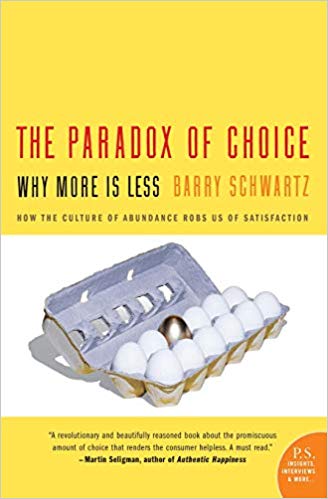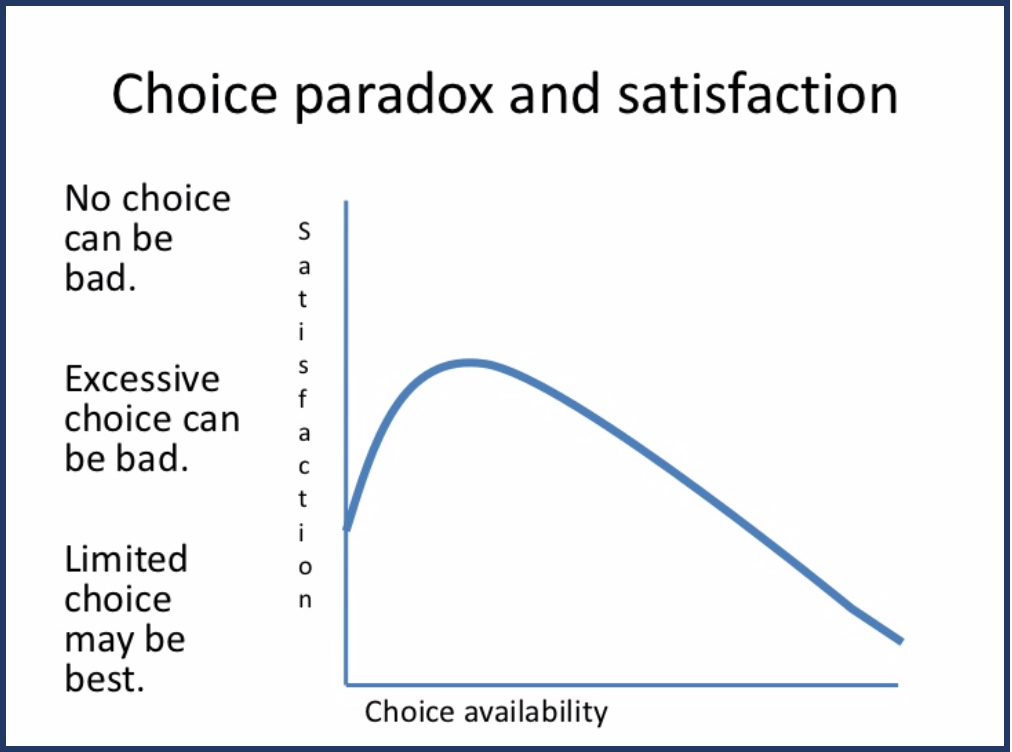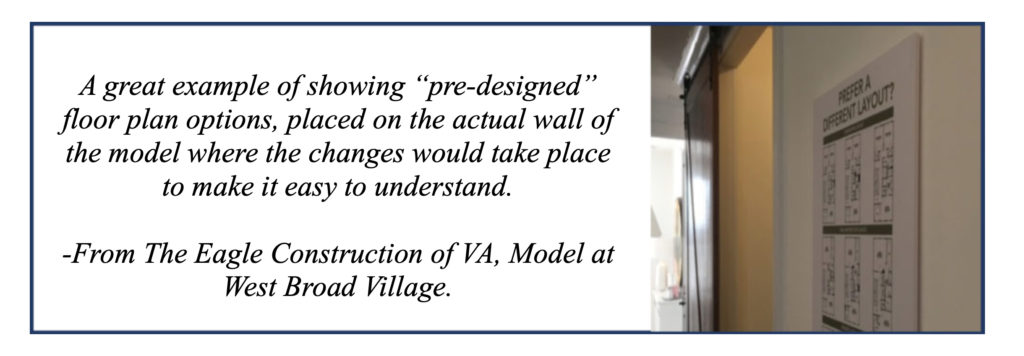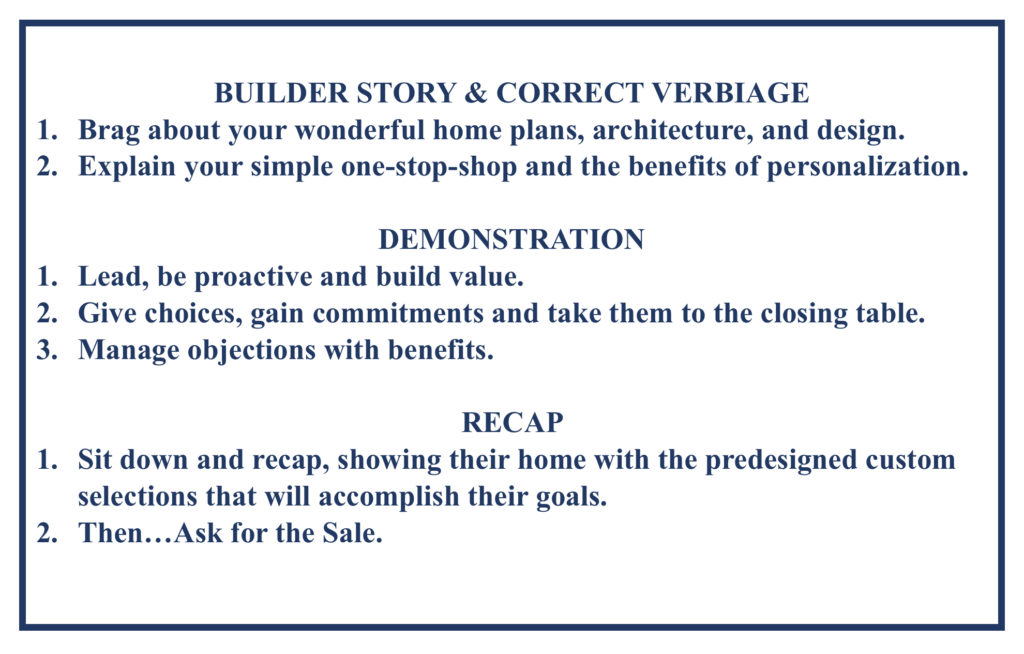One of the most common complaints I hear from builders all across the country is that we get involved in too many unnecessary customization requests. This slows down the sales process, wastes resources, typically turns happy clients into unhappy ones, and frequently doesn’t even lead to the sale.
 Dr. Barry Schwartz, in the Paradox of Choice, talks about overloading clients with too many decisions:
Dr. Barry Schwartz, in the Paradox of Choice, talks about overloading clients with too many decisions:
"Too many choices often produce paralysis rather than liberation, and can create less satisfied customers."
Many clients merely want a beautiful home that resembles the latest trends and finishes they have been watching on TV or on their favorite websites and that also reflect their taste and lifestyle for the next chapter of their lives. When you offer customization to these clients during the sales process, they often become overwhelmed by the myriad of decisions they have to make because they are not experts in design and construction and don't know how much there is to go over when designing a home. The result is that these clients often experience confusion and massive indecision. Interestingly, because their expectations are now elevated due to this concept of a “Custom Home”, they are frequently dissatisfied with the actual results, simply because they don't believe the added investment of time and money spent was worth it when they see the actual difference in their home versus the original model or plan.
Research shows that we humans have to experience something three to seven times to fully understand it. In my sales training, I will often state and restate:
"Tell Them What You are Going to Show Them, Show it to Them,
and Then Recap What You Have Told Them."
With that in mind, here are my three steps to avoid this usually unnecessary and counterproductive Customization Trap.
Own your place in the market, who you are and how that benefits your clients. It is so important that we define ourselves up front with our “Builder Story” during the sales process.
We should talk about our contemporary designs that are professionally thought through and based on feedback from our recent homeowners. These home plans are created by our highly respected architects, along with our interior design team, to bring our clients the very best plans for today’s modern buyer.
We should also talk about your simple “One Stop Shop” process, where clients choose their home and home site, and then visit our state-of-the-art Design Center and “personalize” their home the way they would like it. Please notice the word is personalization and not customization; there is a huge difference between the two words. In the minds of most buyers, what they are really seeking is to select their finishes so that their brand new home will resemble the ones they have been salivating over on HGTV.
Lead - don’t follow - your clients through your home and build value for all of your wonderful included features, along with how they will benefit your clients specifically. The more you amplify what you include, the less they will worry about costly extras.
Instead of waiting for them to ask about upgrading everything, please take control and give them choices of the five to six major decisions that our clients normally care about, such as the kitchen counters, cabinets, appliances, flooring, and maybe a structural choice or two.
Use the word “Included” instead of "Standard" and “Luxury Choice” instead of "Extra".
As you lean on the kitchen island and run your hands over the countertop, à la Vanna White on Wheel of Fortune as she turns vowels, this would sound like the following:
Sales Genius
"We include Granite counters, which are very elegant. We also offer the luxury choice of Quartz. Which would you prefer?"
When they respond with their Commitment, take it to the Closing Table, by saying the following:
Sales Genius
"Great, when we go back to my office, I'll make a note of that, okay?"
So let’s examine what happened here: Instead of letting the client take control and ask what is standard and what is extra, and then start giving you their laundry list of custom requests, you took control and led them pro-actively through your model. They recognized that you are an expert, and when clients see this they will relax and trust you enough to allow you to take them on the journey through the buying process.
Simply put:
"Choices = Commitments = Closings"
You intentionally gave them a choice, they gave you a commitment, and you took it all the way to the closing table. All in under 30 seconds. As I like to say:
"Small Decisions, Lead to Big Sales!"
If they do ask about customization, instead of asking “What would you like to do?”, which implies you are open to doing anything, instead ask the following question during the sales process:
Sales Genius
"What would you like to accomplish?"
 When they give you their response, you can share with them how you can give them what they want with one of your “professionally thought through and professionally pre-selected custom choices”, or luxury options. For example, if the clients want their study brighter, you could suggest adding French doors or transom windows over the door to bring in natural light, both of which you may have as an option, as opposed to having to submit a custom request. Maybe they would like to enclose the open loft upstairs into a bedroom. If this is a request that several clients have made then you make it into a Luxury Choice and have it drawn by your team, so that you can share it with the client that day, along with the details and price, and move forward with the sale.
When they give you their response, you can share with them how you can give them what they want with one of your “professionally thought through and professionally pre-selected custom choices”, or luxury options. For example, if the clients want their study brighter, you could suggest adding French doors or transom windows over the door to bring in natural light, both of which you may have as an option, as opposed to having to submit a custom request. Maybe they would like to enclose the open loft upstairs into a bedroom. If this is a request that several clients have made then you make it into a Luxury Choice and have it drawn by your team, so that you can share it with the client that day, along with the details and price, and move forward with the sale.
*Value Added Tip
If a request, such as turning an open space into a room is a common one, then place the drawing neatly in a picture frame, and keep it in the area where the change would take place. That way you can present this choice to clients proactively in a way that they can easily understand, and they will be happy with what they are committing, preventing future uncertainty or disappointment.

As sales people, we have to believe that allowing our clients to customize will not typically be in their best interest. First of all, we have architects who studied architecture at a collegiate level and have years of experience in designing beautiful homes that suit our clients. As much as our clients may think they are experts, is it possible that they could be disappointed if we allow them to re-design areas of the home without the help of actual experts? Absolutely.
Years ago, I designed a custom home and worked with a builder friend in Palm Beach County. Being a buddy and very patient, he gave me too much room to customize what was already a stunning home plan during the sales process. When we moved in, I loved the home, but couldn’t admit that I was disappointed with the changes that I had made and wished I had just stuck with the original plan with which we had fallen in love.
As of this writing, in most of the markets where I coach sales teams, the market is very healthy and, in some cases, demand even outweighs supply. The hangover from the great recession, wherein we would acquiesce to every buyer whim just to get a sale, thankfully is long past. So it wouldn’t make good business sense to offer unneeded customization when we can still make the sale and create very happy homeowners without it.
In managing the objection of customizing, it is reasonable and fair for us to share the benefits of why we won’t make custom changes. Let’s discuss, create an answer, confirm, and move on.
The simple distillation of all of this would sound something like this:
Sales Genius
"Jack and Diane, thank you so much for your request to customize the Heartland Model. We have found that when we used to offer complete customization like this, it would delay construction too long, the price was often too high, and since we hadn’t built it before our homeowners were often very disappointed with the result.
However, we have a wonderful pre-designed luxury choice, that I believe would accomplish what you are looking for, looks great and would keep you on track both with your budget and move in time frame.
Would it be ok, if I show it to you?"
Drop the mic, walk off stage left…thank you very much.
Remember at the beginning of this article when I mentioned that we have to experience things at least three times to fully understand them? Now it is time to recap and put into writing what we have been sharing verbally with our clients earlier during our presentation and demonstration in the sales process.
As I like to say:
"Never Negotiate on Your Feet, Always Close at Your Seat."
When you sit down with a client at the end, as opposed to standing, this mere change in body language creates an atmosphere which says: “Relax, stay a while, let’s really talk about you and your home needs.” Clearly this can’t be accomplished standing up, when it appears as though your body language is being dismissive of the clients.
 Simply take out the map of the community and recap the benefits to the client, then the homesite, and then the home plan they like the most. Review the plan in detail, including adding names of their children to their bedrooms, if appropriate. When you get to their custom request area, get out the drawing that clearly shows your predesigned changes, and review it slowly and clearly with them. Confirm they understand the change and are happy with it. Offer to add this to their investment review form. Once you have added this, show them their wonderful new home with the luxury features, review the approximate monthly investment, and you have nothing left to do other than what? That’s right …. Ask for the sale.
Simply take out the map of the community and recap the benefits to the client, then the homesite, and then the home plan they like the most. Review the plan in detail, including adding names of their children to their bedrooms, if appropriate. When you get to their custom request area, get out the drawing that clearly shows your predesigned changes, and review it slowly and clearly with them. Confirm they understand the change and are happy with it. Offer to add this to their investment review form. Once you have added this, show them their wonderful new home with the luxury features, review the approximate monthly investment, and you have nothing left to do other than what? That’s right …. Ask for the sale.
I hope this has been helpful. Here is a quick review of all the aforementioned steps:

I trust this has been helpful in helping you handle unnecessary customization and will help you sell more homes in less time at a much higher margin.
I will look forward to hearing about YOUR success.
Truly,